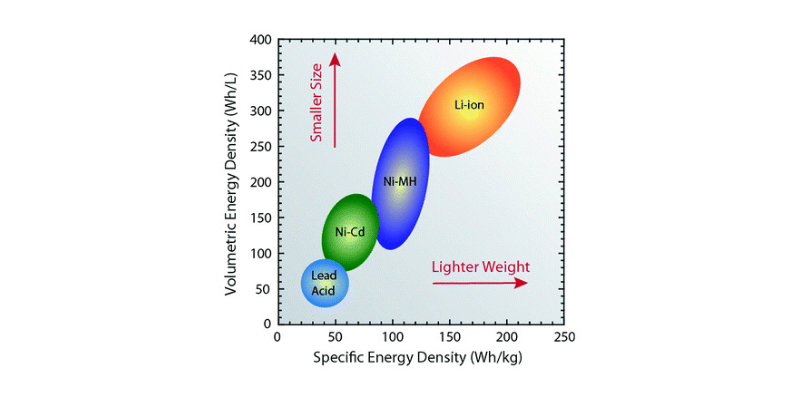Energitäthet är avgörande för batterilagringsprestanda. Det påverkar kapacitet, mångsidighet och effektivitet. Att förstå energitätheten gör det möjligt att låsa upp batterilagringens potential för energihushållning, självförsörjning och hållbarhet.
Vad är energitäthet?
Energitäthet hänvisar till mängden lagrad energi i förhållande till dess vikt eller storlek.
Specifik energitäthet jämför energi med vikt (Wh/kg), medan volymetrisk energitäthet jämför energi med volym (Wh/L).

Varför spelar batteriets energitäthet någon roll?
Batteritätheten är viktig av flera viktiga skäl:
- Effektivitet: Högre densitet innebär mer energi lagrad på mindre utrymme eller vikt, vilket förbättrar portabiliteten.
- Räckvidd och uthållighet: Tätare batterier ger längre fordons räckvidd och drifttider.
- Utrymmesbegränsningar: Tätare batterier maximerar energilagring i begränsade utrymmen.
- Kostnadseffektivitet: Högre densitet minskar antalet batterier som behövs för att uppnå samma kapacitet.
- Miljöpåverkan: Det krävs färre material för att lagra samma energi med högre densitet.
Vilken typ av batteri har för närvarande den högsta energitätheten?
Batterier har olika energitätheter baserat på deras interna kemi:
- Blysyra: 30-50 Wh/kg
- Nickel-kadmium: 45-80 Wh/kg
- Nickel-metallhydrid: 60-120 Wh/kg
- Litiumjon: 50-260 Wh/kg

Vi kan se att det inte råder någon tvekan om det litiumjonbatterier erbjuda den högsta energitätheten. Deras energitäthet sträcker sig från 50-260 Wh/kg, vilket överstiger bly-syra-batterier’ 30-50 Wh/kg. Framsteg inom litiumjonbatteriets kemi, som att använda olika anod- och katodmaterial, har gjort det möjligt för ingenjörer att experimentera med energi och effekttäthet.
Vilka är riskerna med hög energitäthet?
Ju högre energitäthet ett batteri har, desto mer energi kan det frigöra om något går fel.
Litiumjonbatterier innehåller flyktiga flytande elektrolyter som kan orsaka förbränning och utgöra en brandrisk. Därför måste de byggas med säkerhetsfunktioner. Detta begränsar dock hur lätta och kompakta dessa batterier kan bli.

Energitäthet kontra effekttäthet i batterier
Energitäthet och effekttäthet är liknande batterimått, men de skiljer sig åt på ett viktigt sätt.
Energitätheten mäter wattimmar per kilogram, medan effekttätheten mäter watteffekt per kilogram.
Effekttäthet anger hur snabbt energi kan levereras, medan energitäthet visar hur mycket energi ett batteri rymmer.
Slutsats
Ett batteris energitäthet påverkar dess storlek, drifttid och säkerhet. Det är ett nyckelfokus för batteriinnovation, vilket gör litiumjonbatterier populära. Maximering av energitätheten möjliggör mer kompakta, mer hållbara och miljövänliga lösningar, avancerad teknik och möter energibehov. För frågor om att maximera energitätheten, kontakta en expert på Holo Battery.
Relaterade artiklar:

